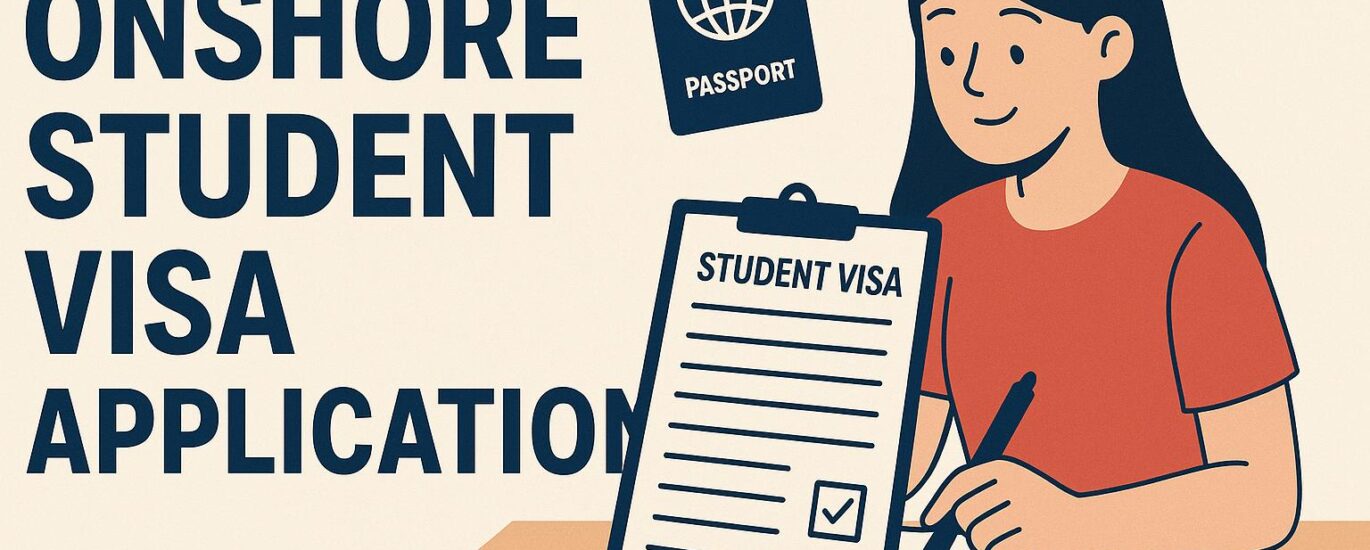If you’re already in a country like Australia, Canada, or the UK and want to extend your stay to study, you might be eligible to apply for an onshore student visa.
This means you don’t have to return home to start a new application — you can apply while staying inside the country.
In this blog, we’ll break down everything you need to know about onshore student visa applications — what they are, who can apply, step-by-step process, tips for success, and the most common mistakes to avoid.
If you’re currently in Australia — maybe you arrived on a visitor visa, bridging visa or another temporary stay — and you’ve realised your dream: to study here, to change course, to upskill, or to take a fresh academic turn, you’ve landed in the right place. Applying for a student visa while you’re already in Australia (an onshore application) is absolutely possible — but it comes with its own rules, timelines and strategic decisions.
As an education consultant who’s helped many students from India, Asia and beyond navigate the Australian student visa process, I know the journey has two faces: the exciting dream of study abroad, and the real, sometimes complex, paperwork & regulation side. My aim here: to demystify the process, give you up-to-date (2025) guidance, share tips from experience, and help you avoid common pitfalls.
Let’s walk together through what you need to know, why it matters, and how you can do this confidently.
🌏 What Is an Onshore Student Visa?
An onshore student visa allows international visitors already in a country (usually on another type of visa) to apply for a student visa without leaving.
For example:
- A person visiting Australia on a tourist visa or working holiday visa can apply for a student visa (subclass 500) onshore if eligible.
- In Canada or the UK, students can apply from inside the country if they meet certain visa and course requirements.
Essentially, “onshore” means you are already in the country when you apply.
By contrast, “offshore” applications are submitted from outside the country (e.g., from your home country).
When we say on-shore application for the Student Visa (subclass 500), we mean that you apply while you are physically in Australia and hold a valid visa. You are not applying from your home country (offshore).
Key points:
- You will apply for the same visa subclass (500) that you would if you were applying from abroad—but the eligibility rules, conditions and supporting documentation can vary for onshore applicants.
- You may continue to stay legally in Australia (via a bridging visa) while your application is processed, provided you lodge before your current visa expires.
- However: some visa types mean you cannot apply onshore (for example, if your current visa has a “no further stay” condition). So careful check is essential.
🎯 Why Apply Onshore?
Applying onshore offers several benefits:
- Stay without interruption – You can remain legally in the country while your new visa is processed.
- No international travel required – Avoid the cost and hassle of flying home just to apply.
- Bridging visa coverage (Australia) – If you’re in Australia, applying onshore often grants you a Bridging Visa A that lets you stay lawfully while waiting for a decision.
- Easy access to institutions – You can meet university staff in person, attend open days, and submit documents faster.
- Smooth transition between visas – For example, switching from a Working Holiday Visa to a Student Visa without leaving the country.
👩🎓 Who Can Apply Onshore?
Eligibility depends on your current visa type, your intended course, and the immigration rules of that country.
Let’s take Australia as an example (though similar rules exist elsewhere):
You can usually apply for a student visa onshore if:
- You currently hold a valid temporary visa (like a visitor, working holiday, or graduate visa).
- Your existing visa doesn’t have “No Further Stay” (Condition 8503).
- You’ve enrolled in a registered full-time course (CRICOS-listed in Australia).
- You meet the Genuine Student (GS) and Genuine Temporary Entrant (GTE) requirements.
- You have sufficient financial means and health insurance (Overseas Student Health Cover).
If you’re unsure whether your visa allows onshore application, an education consultant or migration agent can check this for you.
What’s NEW & important in 2025
Rules and policies evolve. If you’re reading an older guide, you might miss critical updates. Here are the 2025-specific changes you must know:
1. Mandatory Confirmation of Enrolment (CoE) at lodgement
From 1 January 2025, for onshore student visa applications, you must submit a valid Confirmation of Enrolment (CoE) at the time of application. A mere “Letter of Offer” (which was accepted earlier) is no longer sufficient. Gradstar Global+1
This ensures you have fully accepted and enrolled into a course with a registered provider before the visa is assessed.
2. Increased visa application fee
As of 1 July 2025, the base application charge (VAC) for the Student Visa (subclass 500) increased to AUD $2,000 for the primary applicant. Study Australia+2Study Australia+2
Be sure to check if your country or provider has any exemptions or special rates.
3. Restricted on-shore eligibility for some visa holders
Not all current visa-holders in Australia can apply onshore for a student visa. The official guidance lists that holders of certain visas (for example, Visitor visas, Temporary Graduate visas) cannot apply for a student visa while in Australia. Study Australia+1
Therefore, before proceeding, check your current visa conditions (via VEVO) and see if there’s a Condition 8503 (“No Further Stay”) or similar that restricts onshore lodgement.
4. Genuine Student requirement (GS) emphasis
The “Genuine Temporary Entrant” (GTE) test has evolved into what the Home Affairs site describes as the Genuine Student requirement — emphasising that you are genuinely coming to Australia to study and that your course choice, background, future plans and financial capacity align. Immigration and citizenship Website+1
So your statement of purpose and supporting documents should reflect genuine intent, not just “visa access”.
5. Work rights & course packaging clarifications
The official site confirms that while studying you may work up to 48 hours per fortnight during study periods, and unlimited during scheduled course breaks. Study Australia+1
Also, if you are enrolling in multiple courses (“packaging”) under the same visa, the rules around course gaps (less than 2 calendar months) and CRICOS registration are clearly outlined. Study Australia
These details matter — both for compliance and for planning your study-pathway.
6. Financial capacity & health insurance requirements tightened
You must show adequate funds covering tuition, living costs and travel. The “living cost” threshold is referenced in official guidance (for example: at least AUD $29,710 or more, depending on your situation). Study Australia+1
Moreover, you must maintain valid Overseas Student Health Cover (OSHC) for the full duration of your stay. Study Australia
Recent guides also emphasise that sudden bank deposits, short-term large sums or donated funds with no explanation may trigger concerns. ISA Migrations
7. Broader context: international student numbers and visa processing
While not specific to individual applications, it’s worth noting that the Australian govern
ment is adjusting student visa processing priorities and monitoring student numbers (so-called “ghost colleges” crackdown, ministry directives) which may indirectly affect timelines, provider risk ratings and institutional sponsorships. The Guardian+1
As your consultant, I tell my students: “The system is tighter now. Your paperwork must be stronger and clearer than ever.”
🧾 Step-by-Step: How to Apply for an Onshore Student Visa
Let’s go through a typical process (using Australia’s system as an example, but similar steps apply in Canada or the UK).
Step 1: Confirm Your Eligibility
Before anything else, check:
- Your current visa conditions
- Your course start date and enrolment confirmation (CoE)
- That your visa allows further applications from inside the country
If your visa includes “No Further Stay”, you’ll need to request a waiver before you can apply.
Step 2: Choose Your Course and Institution
Select a registered educational provider and a full-time program that fits your goals.
Examples include:
- Universities
- TAFEs or vocational schools
- English language courses (ELICOS)
Make sure your institution is recognized by the government — for instance, CRICOS in Australia or DLI (Designated Learning Institution) in Canada.
Step 3: Gather Your Documents
Here’s a checklist of common documents for an onshore student visa application:
- Passport (valid for your study duration)
- Confirmation of Enrolment (CoE)
- Genuine Student (GS) statement
- Proof of English proficiency (IELTS, PTE, TOEFL)
- Financial evidence (bank statements, payslips, sponsor letters)
- Health insurance (OSHC)
- Academic transcripts and certificates
- Statement of Purpose (SOP) — explaining why you want to study in that country
Tip: Ensure your documents are scanned in color and translated into English if necessary.
Step 4: Apply Online
Most onshore student visa applications are completed digitally through the country’s immigration portal.
Examples:
- 🇦🇺 Australia – immi.homeaffairs.gov.au
- 🇨🇦 Canada – cic.gc.ca
- 🇬🇧 UK – gov.uk/student-visa
Create an online account, fill in your application form, upload documents, and pay the visa fee.
Step 5: Health Checks & Biometrics
You may be asked to:
- Complete a medical examination by a panel-approved doctor.
- Submit biometric data (fingerprints and photos).
Make sure you attend your appointments promptly to avoid delays.
Step 6: Wait for Your Visa Decision
Processing times vary — usually between 4 to 8 weeks, depending on the country and completeness of your application.
If you applied onshore and your current visa expires before a decision is made, you’ll automatically be granted a bridging visa so you can stay legally.
💬 Common Mistakes to Avoid
- ❌ Applying too late — Always apply at least 6 weeks before your current visa expires.
- ❌ Ignoring visa conditions — Check for “No Further Stay” before applying.
- ❌ Incomplete documents — Missing financial or English test evidence causes delays.
- ❌ Weak Statement of Purpose — A poorly written SOP can lead to refusal.
- ❌ Using unreliable agents — Always use a registered migration or education consultant.
💡 Tips for a Successful Onshore Application
✅ Write a strong Genuine Student Statement (GS or GTE):
Explain your career goals, why you chose your course, and how it benefits your future — not just as a way to stay longer.
✅ Show enough financial support:
You must prove you can pay for tuition, living costs, and travel without hardship.
✅ Meet English requirements:
Aim for IELTS 6.0 or equivalent (check your institution’s minimum).
✅ Stay compliant:
Attend classes, maintain enrollment, and don’t work beyond permitted hours.
✅ Seek professional help:
Education consultants can check your documents, draft your SOP, and guide you through complex cases.
📘 Case Study: Switching from Tourist Visa to Student Visa Onshore
Maria, from the Philippines, came to Australia on a Visitor Visa (subclass 600). She fell in love with the country and decided to pursue a Diploma in Early Childhood Education.
Using the onshore student visa pathway, she enrolled at a CRICOS-registered college, obtained her CoE, purchased OSHC, and applied online. Within six weeks, she received her Student Visa (subclass 500) without leaving Australia.
Today, Maria is studying full-time and plans to apply for post-study work rights after graduation.
🕓 Processing Time and Cost (Example: Australia)
| Country | Average Processing Time | Approx. Cost |
|---|---|---|
| 🇦🇺 Australia | 4–8 weeks | AUD $710 (Visa subclass 500) |
| 🇨🇦 Canada | 4–10 weeks | CAD $150 |
| 🇬🇧 UK | 3–6 weeks | GBP £490 |
(Processing times are estimates as of 2025 and vary by application quality and season.)
🔮 What Happens After Approval?
Once approved, you’ll receive your student visa grant letter outlining your:
- Visa grant number
- Conditions (work limits, study obligations, health insurance, etc.)
- Start and end dates
You can now legally study full-time, work part-time (as permitted), and begin your academic journey.
If you plan to stay after graduation, you might later apply for a post-study work visa — another onshore pathway.
❗ When Onshore Applications Are Not Allowed
You cannot apply onshore if:
- Your visa has Condition 8503 (No Further Stay) and you haven’t received a waiver.
- You are on a transit visa or border visa.
- Your current visa has expired.
Always check your current visa status before submitting a new application.
Who can and cannot apply onshore?
Here’s a breakdown:
✅ Likely eligible onshore if you:
- Are currently in Australia on a valid substantive visa (not a bridging visa due to a previous visa breach)
- Do not have a visa condition that prohibits further visa lodgement (e.g., Condition 8503)
- Are studying or about to study at a CRICOS-registered provider and will submit a CoE
- Meet all the other requirements (financial, English language, health, character, genuine intention)
❌ Likely not eligible to apply onshore if you:
- Hold a Visitor visa and plan to apply while still in Australia (Official source: onshore applications from Visitor visa holders are not permitted) Study Australia
- Hold a Temporary Graduate (485) visa and plan to apply onshore when the rules prohibit it
- Have a “no further stay” condition (8503) or other restriction
- Have an expired visa or are awaiting cancellation—better to seek guidance and possibly apply offshore
Tip: Before you apply, log into VEVO (Visa Entitlement Verification Online) and check all your current conditions: expiry date, work rights, any “no further stay” flags. Mistiming or mis-interpreting could lead to refusal or even visa cancellation.
✅ Final Thoughts: Is Onshore Student Visa Application Worth It?
Absolutely!
If you’re already in the country, applying for a student visa onshore can save time, money, and stress. It allows you to continue your education journey without leaving — and opens new opportunities for your future.
However, the process must be done correctly.
Make sure to:
- Check eligibility carefully
- Prepare your documents thoroughly
- Write a strong Statement of Purpose
- Get professional advice if needed
With the right preparation, you can smoothly transition from a visitor to a full-time international student — and take the next big step toward your dream career abroad.
Disclaimer
The information provided in this article is intended for general educational and informational purposes only. Visa rules, eligibility criteria, and immigration policies can change frequently, and requirements may vary depending on your personal circumstances and country of residence.
We strongly recommend that readers consult an officially registered migration agent, education consultant, or the relevant government immigration authority before lodging any visa application.
While every effort has been made to ensure the accuracy of this content at the time of publication, we do not accept liability for any errors, omissions, or decisions made based on this information.
For the most up-to-date visa guidelines, always refer to official government websites such as:
- immi.homeaffairs.gov.au (Australia)
- www.cic.gc.ca (Canada)
- www.gov.uk/student-visa (UK)
- Onshore Student Visa Application: Complete Guide for International Students in 2025
- Australia’s New Student Visa Rules in 2025 – Expert Tips for Indian Students
- How to Improve English & Communication Skills in Australia
- Top Tips for International Students in Melbourne: A Complete Guide
- Your Ultimate Guide to Pursuing an MBA in Australia – Everything You Need to Know
onshore student visa application
student visa australia onshore
apply for student visa inside australia
onshore visa extension
student visa requirements 2025
how to apply student visa
australia subclass 500 visa
study in australia
education visa for international students





